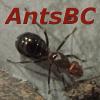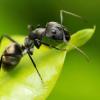- Formiculture.com
- Forums
- Gallery
- Members
- Member Map
- Chat

Queen Ant ID in California
Started By
Alacom
, Jun 22 2019 10:13 PM
7 replies to this topic
#1
 Offline
-
Posted June 22 2019 - 10:13 PM
Offline
-
Posted June 22 2019 - 10:13 PM
1. Location (on a map) of collection: Modesto, California
2. Date of collection: June 22, 2019
3. Habitat of collection: Suburbs in a pool
4. Length (from head to gaster): 9-10mm
5. Color, hue, pattern and texture: Reddish-Brown with a more brown faster.
6. Distinguishing characteristics: Small gaster (maybe semi-claustral), long legs, and large mandibles.
7. Distinguishing behavior: Frequently will use her long legs to curl her gaster up and clean it.
8. Nest description: None
9. Nuptial flight time and date: Either at night on June 21, or early morning June 22.
I found her in the pool and had no idea she was alive until like 3min after I took her out. She could’ve been in there anywhere from 5-14 hours, but it’s more likely that she flew in the morning. Not sure if she’s fertile since she had her wings but who knows.
https://imgur.com/gallery/7uaHi2R
2. Date of collection: June 22, 2019
3. Habitat of collection: Suburbs in a pool
4. Length (from head to gaster): 9-10mm
5. Color, hue, pattern and texture: Reddish-Brown with a more brown faster.
6. Distinguishing characteristics: Small gaster (maybe semi-claustral), long legs, and large mandibles.
7. Distinguishing behavior: Frequently will use her long legs to curl her gaster up and clean it.
8. Nest description: None
9. Nuptial flight time and date: Either at night on June 21, or early morning June 22.
I found her in the pool and had no idea she was alive until like 3min after I took her out. She could’ve been in there anywhere from 5-14 hours, but it’s more likely that she flew in the morning. Not sure if she’s fertile since she had her wings but who knows.
https://imgur.com/gallery/7uaHi2R
#2
 Offline
-
Posted June 22 2019 - 10:42 PM
Offline
-
Posted June 22 2019 - 10:42 PM
Pogonomyrmex sp., maybe Pogonomyrmex hoelldobleri?
I'm not a Pogonomyrmex expert and there is an absolute ton of Pogonomyrmex spp. in California, so unfortunately I can't give you a firm ID. Hopefully Drew or one of the other California 'keepers can. Better photos would probably help.
Also, she's probably one of the semi claustral Pogonomyrmex queens, so I'd recommend feeding her. Pogonomyrmex also benefit from having access to seeds, so keep that in mind as her colony grows.
#3
 Offline
-
Posted June 22 2019 - 10:44 PM
Offline
-
Posted June 22 2019 - 10:44 PM
It looks to be Pogonomyrmex californicus bicolor. Queens that have been found in the pools usually have not had time to drop off their wings. Give her an abundance of seeds.
Edited by AntPhycho, June 22 2019 - 10:48 PM.
- AntsBC and Somethinghmm like this
#4
 Offline
-
Posted June 22 2019 - 11:23 PM
Offline
-
Posted June 22 2019 - 11:23 PM
It looks to be Pogonomyrmex californicus bicolor. Queens that have been found in the pools usually have not had time to drop off their wings. Give her an abundance of seeds.
Do you know what kind of seeds they eat?
Edited by Alacom, June 22 2019 - 11:23 PM.
#5
 Offline
-
Posted June 22 2019 - 11:45 PM
Offline
-
Posted June 22 2019 - 11:45 PM
Do you know what kind of seeds they eat?
I buy a wild bird seed mix put together by a local desert feed business. It is composed of poppy seeds, milo seeds, small black sunflower seed, and possibly canary seed. I know other ant keepers on this forum have used black nyger seed and kentucky blue grass seed. I would recommend buying a mix of birdseed as this gives your harvesters a variety, and they are bound to like a few of the seeds you offer.
#6
 Offline
-
Posted June 22 2019 - 11:49 PM
Offline
-
Posted June 22 2019 - 11:49 PM
Do you know what kind of seeds they eat?
I buy a wild bird seed mix put together by a local desert feed business. It is composed of poppy seeds, milo seeds, small black sunflower seed, and possibly canary seed. I know other ant keepers on this forum have used black nyger seed and kentucky blue grass seed. I would recommend buying a mix of birdseed as this gives your harvesters a variety, and they are bound to like a few of the seeds you offer.
Thanks. Should I put some soil in her test tube?
#7
 Offline
-
Posted June 23 2019 - 12:57 AM
Offline
-
Posted June 23 2019 - 12:57 AM
It is kind of hit and miss with soil in Pogonomyrmex test tubes. It just depends on your queen. According to dspdrew's journal they seem to favor bare test tubes. I have caught many P. californicus this year with some in dirt test tubes, some in bare test tubes, and one in a custom made formicarium. Right now, the only P. californicus queen (from this season) that has laid eggs is the one in my custom grout formicarium I have made out of a VOSS bottle (http://www.formicult...tworlds/page-22),
#8
 Offline
-
Posted June 23 2019 - 9:56 AM
Offline
-
Posted June 23 2019 - 9:56 AM
I think it's most likely P. californicus, but can't tell for sure with those wings in the way.
- AntPhycho likes this
0 user(s) are reading this topic
0 members, 0 guests, 0 anonymous users















